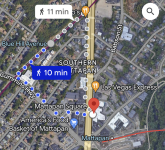I finally made a map in Illustrator! (Which is truly embarrasing to say, but still!)
View attachment 49891
There are actually three versions of this map,
presented and discussed on my blog. Aesthetically, I think I like this one the best. The thick vs thin purple lines create a good visual effect delineating informal "zones" in the map, echoing and reinforcing the zones created by the Streetcar lines transitioning from Subway/El to Surface.
This version is also probably the most illustrative of Illustrator's benefits (sorry, couldn't help the pun) -- through the use of linked symbols and global edits, I was able to (very easily) transform the first version of this map into the one above, simply by selecting paths en masse and changing their width, and applying a global edit to the station icons, and then doing a little bit of cleanup. Compare that to Paint.NET, where... well, to be honest, I probably would have been able to get it done pretty fast in there as well -- I've gotten really good at making a certain style of map/diagram in Paint.NET -- but it would have taken longer, and ultimately would've taken longer to make in the first place.
From a "Fantasy Map" perspective, this is loosely an "Alternate History Map", although it isn't super rigorous. The Suburban Lines are broadly drawn from the routes and stations served in, like, the 1930s, ish? But I was also working based on "the rule of cool", re-using old station names ("Medford Steps" honestly sounds very cool), fabricating new names to replace duplicative ones (my favorite is probably "Pine Tree Brook"), going all-out on "circuit" routes... I wasn't super worried about accuracy or full-out consistency or full-out plausibility.
One fun thing I like about Fantasy Maps in general, and Alternate History Maps in particular, is that it gives you latitude to come up with ideas that are just as bad as the ones we ended up with in real life, but bad in a
different way. Case in point, this map's "Revere-Lynn High Speed Line", which recapitulates the BRB&L's original two-seat train-ferry journey to downtown, but transforms it into a two seat train-subway journey. (Which, honestly, may be one of the more plausible ideas in the whole map.)
Why not combine the (red) Central Line and the (blue) High Speed Line? Well, you see, the High Speed Line continues to run narrow gauge service on vehicles that are hard to classify strictly as light rail or heavy rail; what's more, the transfer station at Boston Air Port was built at great expense as a dual-level station with the High Speed platform superimposed above the Central Line terminating platform below, to maximize ease of transfers and flow of passenger traffic between platforms. Additionally, the positions of tracks and stations would have required the abandonment and/or complete rebuild of Boston Air Port station to enable through-running. So, you see, it's simply never been possible to change the status quo.
View attachment 49892
(And don't even get me started on how terrible the Streetcar Subway Elevated Loop system would have been!)


